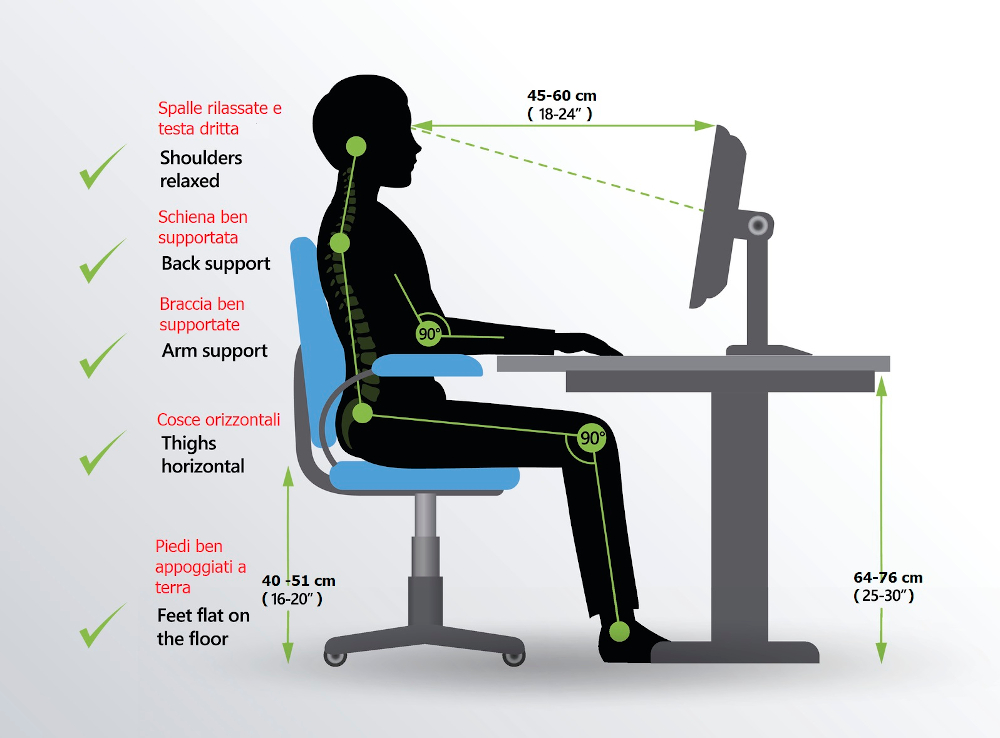Ergonomic office chairs
In the previous post Ergonomics in the office we talked about the meaning of ergonomics and the benefits that an ergonomic office can offer.
In this post we will instead talk about ergonomic office chair and how to choose one.
An office chair must offer a set of adjustments that allow most users to find a comfortable seating position.
The fact that a chair is comfortable for us is a subjective evaluation, related to some physical parameters, for example our stature, the shape of our back, etc.
But in general, an office chair can be defined as ergonomic if a scientific study has been conduced proving its comfort for the 90% of possible users, or if it meets the requirements of the reference Standard.
In fact, the manufacturers of chairs and the scientific community have promoted studies that have as a synthesis this concept of reference Standard (Normative).
Contents
The EN1335 Normative for office chairs
The Normative (Standard) is a set of rules respecting which an office chair can be defined ergonomic and suitable for professional and continuous use in the office (8 hours a day).
For Office chairs in the European market the EN1335 Standard provides a series of dimensional requirements to guarantee the ergonomics of the chair. Respecting these dimensions and these adjustments, it is as if the chair had been subjected to the scientific study of which we spoke above.
For example, the Standard provides that the back lumbar support must have an adjustable height from 6.7”-8.66” (17-22 cm) with respect to the seat. This means that all users who will use that chair, from the smallest to the tallest, in the 90% of cases will be able to adjust the support in a comfortable position.
And so also for the seat, for the mechanism and for the armrests, specific regulation fields are provided by the Standard.
The standard also provides for load and fatigue tests of the chair, so that it is also robust and durable, suitable for continuous use.
There are several accredited laboratories to certify correspondence with respect to the products standard.
For example in Italy the CATAS, of which SbS is a member, verifies the compliance of the seats with respect to the EN1335 Standard.
The SbS seat kits are almost entirely tested according to this Standard, both at the internal Lab test (especially during the product design phase) and at CATAS for an official certification.
Ergonomic chair and video-terminal working position: recommendations
An ergonomic chair allows you to work in the RECOMMENDED STATIC POSITION:

The checklist for a correct posture is:
– feet well resting on the ground (possibly also with the use of a footrest)
– horizontal thighs and vertical calves (angle of about 90 ° between them)
– arms well supported by the armrests and folded at about 90 °
– back well supported by the chair lumbar support
– shoulders and neck relaxed, head straight
– distance from head to screen approx 18-24” (45-60 cm) and with the upper edge approximately at eye level
This posture called STATIC is the posture in which muscle work is minimized.
It is clear that keeping a posture for 8 hours is impossible.
In fact, the most recent research in the ergonomic field (1) recommends that this posture has to be alternated with a DYNAMIC seating in which the chair allows the pelvis to perform light movements favoring better blood circulation in the body.
Another suggestion from these researches (1): alternate sitting work phases with standing work phases, perhaps thanks to the use of suitable workstations or simply taking advantage of a short walk at regular intervals.
(1) GOOD WORKING POSITIONS – OSHA





